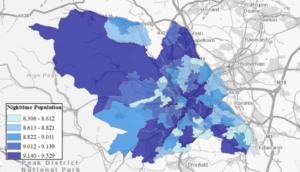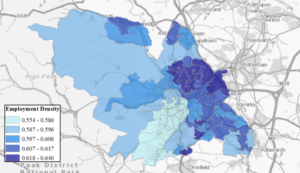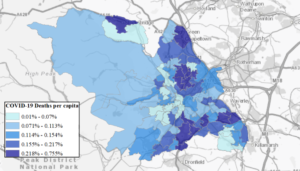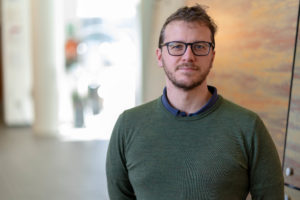One of the most striking features of the COVID-19 pandemic is the marked spatial difference in the spread of the virus. Initially, urban areas were hit hardest by Covid-19, followed by smaller cities, rural towns and small hamlets. Differences in population density and occupational concentration have been proposed as key factors explaining the urban-rural difference in spread of the virus. Spatial differences are also apparent in how the virus spreads within a city. For example, neighbourhoods with high levels of deprivation have experienced high infection rates relative to low-deprivation neighbourhoods.

Study Background and Design
Understanding how the structure of a local economy perpetuates the pandemic is important. COVID-19 has highlighted the need for targeted public health measures to address highly localised outbreaks linked to different types of social interaction. This requires disentangling the importance of many different factors. For example, neighbourhood density, or occupational composition is likely to be correlated with the crowding of houses. Further, when looking at occupational composition, we want to distinguish between where workers live and where worker work to understand how occupation and transmission are related.
Our research, funded by the RSA small grant scheme on Pandemics, Cities, Regions & Industry, combines highly granular data for 7200 neighbourhoods across England to quantify the importance of population density versus employment composition on the spread of COVID-19. We use different measures of neighbourhood population density, including satellite imagery, to distinguish between daytime and night-time populations. Employment composition is measured as the concentration of key workers living in a neighbourhood, those workers who have continued working onsite even during periods when lockdown restrictions were in place. These data are analysed using econometric techniques that allow us to quantify the importance of these factors in explaining the spread of COVID-19 within a city, while controlling for many other alternative explanations. Our analysis provides a number of important insights.
Insights from data analysis
First, both higher population density and higher keyworker concentration lead to a higher incidence of COVID-19. Interestingly, the concentration of keyworkers who work (rather than live) in a neighbourhood is much less important. This finding is consistent with onsite employment during the pandemic facilitating spread the virus through workers contracting and bringing the virus home, but not spreading the virus within the neighbourhood in which they are working.
Second, we find that population density and onsite employment density are of similar importance, except in the most deprived neighbourhoods. In these neighbourhoods, the impact of a high concentration of keyworkers leads to a significantly larger prevalence of COVID-19 compared to otherwise similar less deprived neighbourhoods. We do not find this same effect for population density, for which the effect is similar across neighbourhood deprivation levels.
It is possible that lower income, more severe health deprivation, and greater crowding in housing facilitate the spread of the virus carried into the local community by keyworkers.
Third, population density and keyworker concentration lead to a higher prevalence of COVID-19 only during lockdown periods. During July and November of 2020, when the UK enjoyed a reopening, the importance of these two factors disappears. However, this result is not the same for all neighbourhoods. In the UK’s most deprived neighbourhoods, population density and keyworkers concentration continued to be important in the spread of the virus when strict public health lockdown measures are lifted. This could reflect social interactions between keyworkers and the rest of the population that differ by neighbourhood deprivation. It could also reflect differences in the types of jobs done by keyworkers living in more and less affluent areas.
Case Study: Sheffield
We can get a sense of these results by considering the city of Sheffield, in Figure 1, were there are stark differences in the distribution of population and keyworker density. Keyworkers are highly concentrated in neighbourhoods in the east side of the city, which are also neighbourhoods characterised by higher levels of economic deprivation and a higher incidence of COVID-19.
Readers can interact with our research through an interactive mapping tool available on the project website, which helps to visualise the dynamic evolution of COVID-19 as well as the spatial correlation with population, employment density, and other socio-economic metrics.
Figure 1: Distribution of night-time population density, keyworkers employment density and COVID-19 deaths per capita across neighbourhoods in the Sheffield Local Authority District



This research project, using granular data and novel data sources, allows us to further our understanding of what factors are important in the contagion of COVID-19, and understanding the trade-off between public health and economic concerns. A more nuanced understanding of where and how contagion takes place is increasingly important in looking forward to develop resiliency in our ‘post-virus’ cities.

Dr. Enrico Vanino (Email; Twitter @EnricoVanino; Website) is a Lecturer (Assistant Professor) in the Department of Economics at the University of Sheffield. He works on issues related to international economics, urban and regional economics, firms’ productivity and the economics of innovation. He holds a PhD in economics from the University of Birmingham, and prior to joining the University of Sheffield he worked as a Fellow in Economic Geography at the London School of Economics.
Are you currently involved with regional research, policy, and development? The Regional Studies Association is accepting articles for their online blog. For more information, contact the Blog Editor at rsablog@regionalstudies.org.